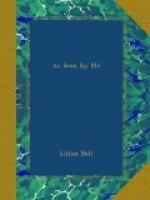We drove over the same road from the Piraeus to Athens, but in the two months of our absence they had mended a worn place in this road and had unearthed a most beautiful sarcophagus, which they placed in the national museum. The cement which held it on its pedestal was not yet dry when we saw it. They do not know its date, nor the hand of the sculptor who carved it, yet it needs no name to proclaim its beauty.
I have now seen Athens as I wanted to see it. I have seen it consecutively. It was beautiful to begin with the Acropolis and to take all day to examine just the frieze of the Parthenon. We had to have written permission, which we received through the American minister, to allow us to climb up on the scaffolding and get a near view of it. But we did it, and we were close enough to touch it, to lay our hands on it, and we waited hours for the sun to sink low enough to creep between the giant beams and touch the metopes so that we could photograph them. Of course, we could have bought photographs of them, but it seemed more like possessing them to take them with our own little cameras.
The central metope is the most beautiful and in the best state of preservation of all this marvel from the hand of Phidias; yet the work of destruction goes on, as only last year the head of the rider fell and broke into a thousand pieces, so that only the horse, the figure, and the electric splendor of his wind-blown garments floating out behind him remain. There is so little of this frieze left that it requires the full scope of the imagination, as one stands and looks at it, to picture this triumphal procession of Pan-Athenians which every four years formed at the Acropolis and wound majestically down through the Sacred Way to the Temple of Mysteries to sacrifice to the goddess in honor of Marathon and Salamis.
But we followed this road ourselves. We, too, took the Sacred Way. On the loveliest day imaginable we drove along this smooth white road; we saw the Bay of Salamis; we wound around the sweetheart curve of her shore; the purple hills forming the cup which holds her translucent waters are the background to this famous battle-ground; and beyond, set on the brow of one of these hills like a diadem, is all that remains of the Temple of Mysteries. Broken columns are there, pedestals, fragments of proud arches, now shattered and trodden under foot. Its majesty is that of a sleeping goddess, so still, so tranquil, proud even, in its ruins; yet in such utter silence it lies. In the cracks of the marble floors, in the crannies of the walls, springing from beneath the broken statue, voiceless yet persistent, grow scarlet poppies—the sleep flowers of the world, yielding to this yellowing Temple of Mysteries the quieting influence of their presence.
The next day, almost in the spirit of worship, we went to Marathon. If Salamis was my Holy Grail, then Marathon was my Mecca. We started out quite early in the morning, with relays of horses to meet us on the way. It tried to rain once or twice, but it seemed not to have the heart to spoil my crusade, for presently the sun struggled through the ragged clouds and shed a hazy half light through their edges, which completely destroyed the terrible, blinding glare and made the day simply perfect.




